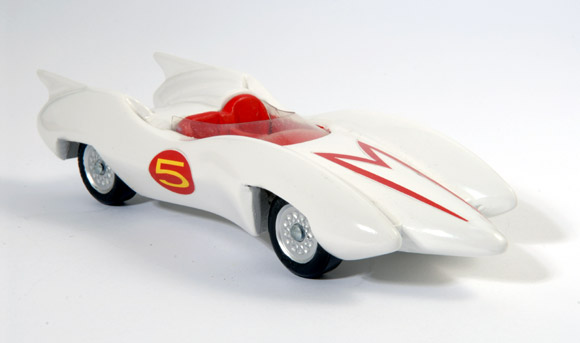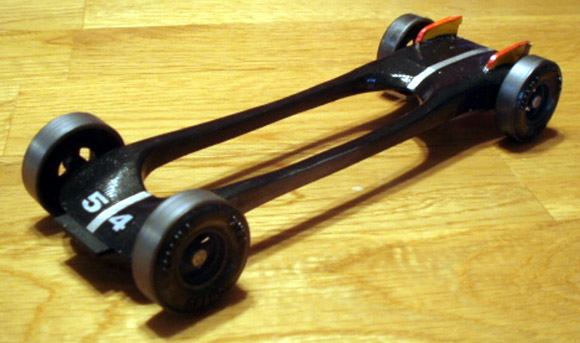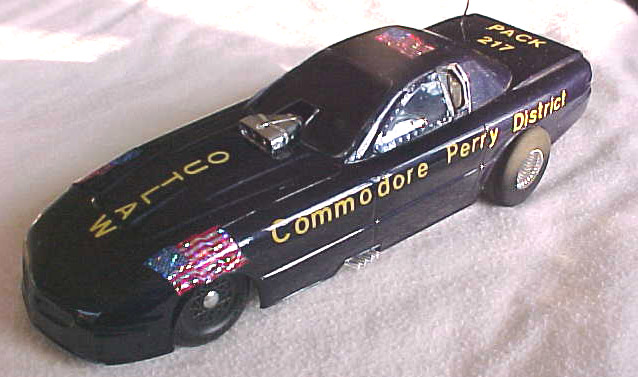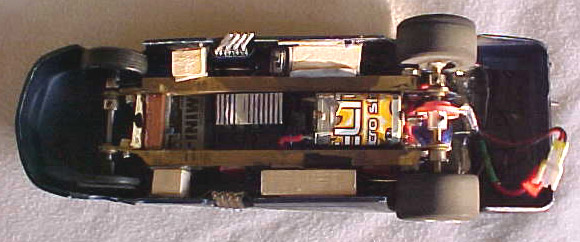– Feature Article – Advice to the Beginner: Keep it Simple
– Pinewood Derby Car Showcase
– Memory – Outlaw Race is a Winner
– Q&A
Advice to the Beginner – Keep it Simple
(Originally published in Volume 5, Issue 8 – January 11, 2006)
Introduction
Countless times I have had the following phone conversation: “Hi, my son just got a pinewood derby kit, but when we opened it all we found was a block of wood, four wheels, and some nails. What the heck are we supposed to do with it? I expected it to have a car that looked like the photo on the box!”
It can be very daunting to participate in your first pinewood derby race. The event demands some woodworking skill, some understanding of physics, and access to basic tools and supplies. For many people one, two, or three of these requirements are missing.
So, let me share some advice for those of you that are participating in your first race.
Car Body
Unless you have some experience with woodworking and the tools of the trade, then I suggest going with a basic wedge-type design. Not only is it a simple shape to cut, it also simplifies sanding and finishing. All that is needed to build a wedge is a saw and a hand drill. If you are missing these items, then you can purchase wedges already cut and drilled from several sources.
I recommend recessing weight into the car body. With a wedge, the easiest way to do this is to glue lead wire, in holes drilled into the car (see the next section). Holes drilled into the side or back of the car can be covered with wood plugs or with wood filler before finishing.
Note that on many kits – including BSA kits – one axle slot is closest to the end of the block. I recommend using that closest slot as the rear slot (the opposite of the car pictured on the BSA kit box).
Weight And Placement
To ensure that the car performs well, you will need to add weight to bring the completed car to the maximum weight (usually 5 ounces). An easy weight to use is lead wire. This product is 3/8 inch in diameter and can be easily cut into pieces and reshaped. Note that this product is not typically available in hobby shops, but is available from some on-line stores. Generally, you will need between 2.5 and 3 ounces of weight for a wedge-shaped car.
On most tracks, best performance is attained by locating the added weight towards the rear of the car. For a wedge-shaped car, a good rule of thumb is to place 1/3 of the added weight behind the rear axle, 1/3 just in front of the rear axle, and the final 1/3 about 1-1/2 inches in front of the rear axle.
Car Finish
If you are unfamiliar with painting models, and you are making a simple shape (like a wedge), then consider using a Body Skin. These full body decals work well on simple cars.
If you decide to paint, then consider using Acrylic hobby paints. They generally work well and clean up with water. Avoid getting paint in the axle slots – use masking tape to cover the slots.
Wheels
Although the wheels can be used directly from the box, some preparation is recommended. This includes sanding the tread surface and inside edge (with the wheel mounted on a wheel mandrel and spinning on a drill), squaring or coning the inside wheel hub, and polishing the bore. Tools are available from on-line stores to assist in these preparation steps. As an alternative, prepped wheels are available from many on-line stores. Just make sure to check your local rules to find out what is allowed/disallowed in your race.
Axles
If your kit uses nail-type axles, then you certainly want to remove the flaws by placing the nail in the chuck of a drill, point first, and then applying a small file to the spinning axle. Next, polish the axles with fine grit, wet sandpaper, and/or other polishing materials. As in the case of wheels, prepped axles are also available from many sites.
Lubricant
The wheels and axles must be lubricated. Unless restricted by your local rules, go with graphite. It is the number one lube used, and is readily available. Be sure to work the graphite into the wheel hub by spinning a wheel on an axle multiple times. To keep your car clean, and to ensure a thorough lube job, I recommend lubricating the wheels and axles before attaching them to the car.
Final Assembly
Mount the wheels and axles onto the car by inserting the axles into the axle slots or axle holes. The Pro-Axle Guide is available to greatly simplify this step.
The wheel hub to car body gap should be about 30 thousandths of an inch. The Pro-Axle Guide has a built in gap gauge, and other gap gauges are available. But in a pinch, you can use a standard credit card as a gap gauge. Just place the credit card against the side of the car, and insert the axle until the inside wheel hub is snug against the credit card. Then remove the card.
With axle slots, the axles will need to be glued in place (a dab of white glue spread over the exposed axles works well – just keep the glue away from the wheels). However, before gluing the axles in place, check and adjust the alignment of the car (see Volume 5, Issue 6 – Wheel Alignment: Make It Straight!).
Conclusion
I hope that this break-down of the car building steps will ease your mind as you build your first car. Just remember, take your time, make sure your child is fully involved, and enjoy the process. Good luck!
Pinewood Car Showcase
Speed Racer: Mike McBride
I have dozens of cars, some built for speed some just to look at. This car was designed after the Speed Racer Mach 5. It has not been raced yet. It is wider than BSA specs, but will be raced in a modified class that we do with our church’s men’s group every year.
Winged Rail: Rick Ellis
This car raced in our church’s 2009 Awana Grand Prix. It got the award for best workmanship and finished fourth for speed in the Open Division. It weighed exactly 5.00 ounces on the entry scale and has three wheelson the ground. This was my second derby. I took first in the Open Division last year and second overall. I don’t mind finishing fourth as I helped build the other three cars.
Commodore Outlaw: Bill Klingler
This car is radio controlled, and will cover the track in a bit over a second. I can run it fast or slow. I can also throw it into reverse and back it up the track. It’s great fun to stop it on the track, wait for a gravity car to pass, and then do a burn-out and pass the other car.
The electronics are from the Losi Mini-T RC car. The motor is an upgraded one over the one that comes with the Mini-T, and the drivetrain is built from slot car parts. It uses a 7.2V Nickel Metal hydride battery. The body is from a car kit.
Pinewood Derby Memory
Outlaw Race is a Winner
At last year’s derby we had so many families hanging out after the race having a good time that we thought next year we’d add an “Outlaw Race” open to anyone. The only rules were that the car had to fit on the track, not damage it, and not interfere with any other racer.
We had a great turnout with all kinds of outlaw cars. We had brother racing sister, parents vs. kids, grandparents vs. grandkids, and Cubmaster vs. everyone! Everyone was very pleased with all the competition and are anxiously waiting for next year’s race.
I entered my car, the 10 ounce “Dragonator”. The car beat other cars that weighed 2 pounds or more!! And after all the years of helping my own son build cars, this was the first time we’d won anything. Needless to say my boy was a bit jealous of my Outlaw trophy which is proudly displayed in my gameroom.
For next year’s Outlaw race the gauntlet has been laid down and challenges made from all.
Thanks for putting on a great site with good information.
Rick Wold
Pack 457, Covina, CA
Q&A
Hey, we just ordered a Pro-Body Tool II, but it doesn’t fit over the BSA Pinewood Derby block. It’s a few microns too narrow and it just won’t fit. What do I do?
The BSA blocks vary a bit in size — some are too big, and some too small. If the block is too big, then sand a little bit off of one side to get the tool to fit. If the block is too small, then insert paper on one side to tighten up the fit.
How do you keep graphite from getting all over the car when you’re lubing it up? My son had a sweet looking car until he put graphite on it, and it got all over the car and ruined the paint job.
I recommend lubricating the wheels and axles before mounting them on the car. Make sure to wipe off any excess lube before mounting.
Is it better to have a smaller or larger wheel bore?
Generally, the smaller bore is better, as it has a better fit to the axle, and the distance around the bore is smaller (less surface to contact the axle per revolution).
Want Answers?
Do you have a pinewood derby-related question? If so, e-mail us your question.We answer all questions by e-mail, but not every question will appear in the Q&A section of the newsletter.
Back Issues
Are you a new subscriber, or have you missed some of the previous newsletters? Don’t miss out; all of the issues for Volume 5 through Volume 17 are posted on our web site.
Newsletter Contributions
We welcome your contributions. If you would like to contribute an article, a web site review, a speed tip, or a pinewood derby memory, please e-mail us.
Subscription Information
The Pinewood Derby Times is a free e-newsletter focused on pinewood derby racing. It is published biweekly from October through March.
If you haven’t already done so, please forward this issue to your pinewood derby friends. But please don’t subscribe your friends. Let them decide for themselves. Thanks.
If this newsletter was forwarded to you, why not subscribe to receive this newsletter. There is no cost, and your e-mail address is safe, as we never sell or share our distribution list.
To subscribe, send a blank e-mail to
[email protected]
You will receive a confirmation e-mail. Reply to the confirmation e-mail and you will start receiving the Pinewood Derby Times with the next issue.
Randy Davis, Editor, Pinewood Derby Times
E-Mail: [email protected]
(C)2018, Maximum Velocity, Inc. All rights reserved. Please do not reprint or place this newsletter on your web site without explicit permission. However, if you like this newsletter we grant permission, and encourage you to e-mail it to a friend.
Maximum Velocity disclaims any personal loss or liability caused by utilization of any information presented in this newsletter.
The Pinewood Derby Times is not specific to, and is not affiliated with the Boy Scouts of America, YMCA, Awana, or any other organization.
(R)Maximum Velocity is a registered trademark of Maximum Velocity, Inc.
(R)Pinewood Derby is a registered trademarks of the Boys Scouts of America.
(R)Awana is a registered trademark of Awana Clubs International.
All other names are trademarks of their respective owners.




